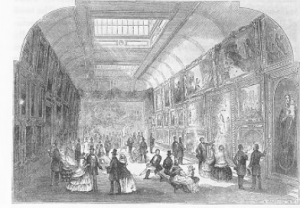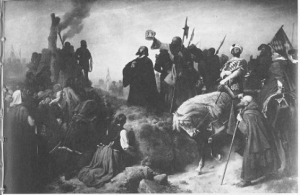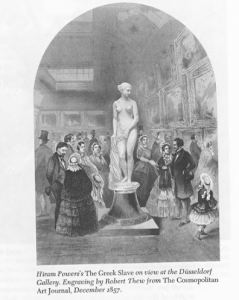Active Dates: 1849-1866.1 R. L. Stehle, “Düsseldorf Gallery, New York,” New-York Historical Society Quarterly, October 1974, 305-314, accessed April 13, 2020, http://digitalcollections.nyhistory.org/islandora/object/islandora%3A15831#page/1/mode/2up.
Location:2All dates and locations from R. L. Stehle, “Düsseldorf Gallery, New York,” New-York Historical Society Quarterly, October 1974, 305-314, accessed April 13, 2020, http://digitalcollections.nyhistory.org/islandora/object/islandora%3A15831#page/1/mode/2up.
1849: “Dusseldorf Academy of Fine Arts” 548 Broadway
1857: Sold by Boker to Cosmopolitan Art Association of Sandusky, Ohio, remains in the same location.
1860: 625 Broadway, building by Henry W. Derby
1862: collection sold via auction at the original location, 548 Broadway.
1866: some unsold paintings remained on view at the 625 Broadway location, despite gallery no longer in operation
Specialty: Old master paintings, and German works from the Düsseldorf school.
Gallery History
John Godfrey Boker (1795-1860), the founder of the Düsseldorf Gallery, emigrated to the United States around 1825 and remained in New York until his death in 1860. He did not come from an artistic background and was later appointed as American consul to Remscheid and Basel. He was on the committee of the Art-Union at Düsseldorf, a school of art established by the King of Prussia and acted as its Honorary Secretary in the US. The New York branch was thus considered an extension of the Rhenish Art Union.3 Stehle, “Düsseldorf Gallery,” 306.
The collection operated on a membership basis, in which Americans could subscribe by paying an annual fee that contributes to the purchase of paintings for the collection; according to the gallery’s records, paintings would then be distributed to subscribers by lot, though the best ones were kept on public view.4 Stehle, “Düsseldorf Gallery,” 306.
The works of art, which presumably started as Boker’s personal collection, included German works from the Düsseldorf school, and the gallery held yearly exhibitions.5 Stehle, “Düsseldorf Gallery,” 305. At first the exhibition took place in the Church of Divine Unity on Broadway, and later the exact location became 548 Broadway.6 Stehle, “Düsseldorf Gallery,” 307.
Under Boker’s tenure as director, paintings were frequently sold and replaced with new acquisitions, thus diffusing Düsseldorf School works into the rest of the country. Notable works include two pieces by Emanuel Leutze, mentioned in the catalogue of 1849, and Carl Friedrich Lessing’s great work The Martyrdom of Huss, to which Boker dedicated a significant portion of his 1851 catalogue and included numerous critical spreads by the press.7 Stehle, “Düsseldorf Gallery,” 308-309. In 1862, though there was no longer the same exclusivity devoted to artists from the Düsseldorf school.8 Stehle, “Düsseldorf Gallery,” 313.
Illustrations



Date Written: April 13th, 2020
Contributors: SL, CP
Secondary Sources
Gerdts, William H. “Good Tidings’ to the Lovers of the Beautiful’: New York’s Düsseldorf Gallery.” American Art Journal, 30, no. 1/2 (1999): 50-81. https://doi.org/10.2307/1594632.
Stehle, R. L. “Düsseldorf Gallery, New York.” New-York Historical Society Quarterly, October 1974, 305-14. Accessed April 13, 2020. http://digitalcollections.nyhistory.org/islandora/object/islandora%3A15831#page/1/mode/2up.
